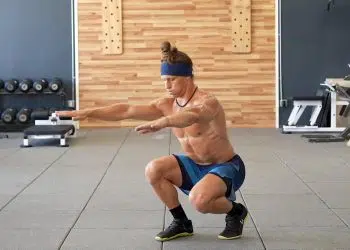The dumbbell fly is one of the most popular pectoral exercises. Most beginner programs will pair it with the bench press for the chest training routine. When done properly, the dumbbell fly is a relatively safe exercise that moves the arms through the horizontal plane to achieve chest adduction.
However, the problem is that the dumbbell fly is often done incorrectly. The two biggest issues are that people use too much weight and bring their arms down too low. Both of these things can cause shoulder issues due to overextension. Too much weight can also cause a pec tear in the fully arm-extended position, where the pectorals are weakest.
As a personal trainer, I discovered that it was better to provide safer dumbbell fly alternatives than relying on beginners to perform the exercise properly in my absence. As a result, I relied on these eight dumbbell fly alternatives that, while still working through the same plane of motion, place far less stress on the shoulder joint.
This article details the eight dumbbell fly alternatives, pro tips on optimizing your form, frequently asked questions, and their answers.
Dumbbell Fly Muscles Worked
The main muscles worked with the dumbbell fly exercise are:
1. Pectorals
The pectorals are fan-shaped muscles covering the upper third of your anterior torso. The muscle fibers originate on the sternum, clavicles, and ribs and insert into the upper part of the humerus (upper arm).
Level Up Your Fitness: Join our 💪 strong community in Fitness Volt Newsletter. Get daily inspiration, expert-backed workouts, nutrition tips, the latest in strength sports, and the support you need to reach your goals. Subscribe for free!
The function of the pectorals is to bring the upper arm forward vertically and together horizontally (adduction). The dumbbell fly brings the arms together and then extends them out to cover the adduction side of the equation.
2. Front deltoids
There are three heads of the deltoids:
- Anterior
- Medial
- Posterior
The anterior (or front) delt head is involved in forward-pressing exercises such as the bench press. It is also involved, though to a lesser degree, in the fly action.
3. Triceps
The triceps is a three-headed muscle at the back of the upper arm. Its function is to extend or straighten the elbow. You activate your triceps when you bring your arms back up from the extended position.
Dumbbell Chest Fly How To
Steps:
- Lie on a flat bench with a relatively light pair of dumbbells in your hands. Plant your feet on the floor.
- Maintain a natural arch in your lower back with your hips and shoulder blades on the bench.
- Hold the dumbbells directly above your mid-chest, with your elbows slightly bent. The elbows must remain locked in this position through the movement.
- Hinging from the shoulder joint, bring the arms out and down in a slow, controlled manner.
- Stop when your hands are in line with your torso (do not go any lower!).
- Reverse to the start position.
Pro Tip:
- Use a moderate weight that you can control.
- Do not bring your arms down below the torso level.
- Imagine you are hugging a tree.
Benefits:
- Moves the pectorals through horizontal adduction.
- Provides for full pectoral extension and contraction through the horizontal plane.
- Target Muscle Group: Pectorals
- Secondary Muscles: Front deltoids and triceps
- Type: Hypertrophy
- Mechanics: Isolation
- Equipment: Dumbbells
- Difficulty: Intermediate
- Best Rep Range:
- Hypertrophy: 8-12
- Strength: 1-5
The 8 Best Dumbbell Fly Alternative Exercises
Given below are the eight best dumbbell fly alternatives:
1. Floor Fly
The floor fly allows you to use a heavier weight than the standard dumbbell fly in a safe manner. The floor prevents you from going lower than your torso. Being able to press into the floor also allows you to handle more weight.
Steps:
- Sit on the floor with your knees bent and a dumbbell on either side.
- Rock back to lower to a lying position with the weights extended above your body.
- Bend your elbows slightly and lock them in that position. Now hinge at the shoulder joint to lower the weight out and down to the floor.
- Push your triceps into the floor to perform a press in order to return to the start position.
Pro tip: Focus on the eccentric part of the movement, lowering to a three-count.
Benefits of the floor fly:
- Safer than the standard dumbbell fly
- Allows you to use more weight
- Target Muscle Group: Pectorals
- Secondary Muscles: Triceps and front deltoids
- Type: Hypertrophy
- Mechanics: Isolation
- Equipment: Dumbbells
- Difficulty: Intermediate
- Best Rep Range:
- Hypertrophy: 8-12
- Strength: 1-5
2. Cable Fly
The cable fly allows you to work the pectorals from a variety of angles, depending on where you position the pulleys. As a result, you are able to align the movement with the muscle fiber direction.
Training with cables also places constant tension on the working muscle through the entire range of motion and in both the concentric and eccentric parts of the rep.
Steps:
- Set the pulleys on a double cable pulley machine at shoulder height. Stand three feet in front of the machine, facing away from it.
- Grab the cable handles and bring them together in front of your mid-chest with your arms slightly bent and locked in that position.
- Hinge from the shoulder joint to bring the arms out and back in arcing movement until your hands are in line with your torso.
- Return to the start position under control.
Pro tip: Focus on fully extending the pecs and then forcefully contracting them in the finish position.
Benefits of the cable fly:
- Allows you to work the muscles from different directions
- Constant tension on the working muscle
- Target Muscle Group: Pectorals
- Secondary Muscles: Triceps and front deltoids
- Type: Hypertrophy
- Mechanics: Isolation
- Equipment: Cable Pulley
- Difficulty: Intermediate
- Best Rep Range:
- Hypertrophy: 8-12
- Strength: 1-5
3. Slider Push-Up
The slider push-up allows you to perform both horizontal adduction and vertical pressing in one exercise. By placing sliders under your hands you’re able to move the arms in and out while performing the push-up movement.
Steps:
- Get down on a slick floor (such as polished hardwood or kitchen tiles) in the high plank position with a pair of sliders under your hands.
- Spread your hands apart until your chest is a few inches away from the floor.
- Slide your hands in together and begin to perform a push-up.
- Return to the start position.
Pro tip:
- If you don’t have sliders, you can put a pair of hand towels under your palms.
- Perform the exercise slowly and under control.
Benefits of the slider push-up:
- Combine horizontal adduction with vertical pressing.
Level Up Your Fitness: Join our 💪 strong community in Fitness Volt Newsletter. Get daily inspiration, expert-backed workouts, nutrition tips, the latest in strength sports, and the support you need to reach your goals. Subscribe for free!
- Target Muscle Group: Pectorals
- Secondary Muscles: Triceps and front deltoids
- Type: Hypertrophy
- Mechanics: Compound
- Equipment: Sliders
- Difficulty: Intermediate
- Best Rep Range: 10-20
4. Plate Pinch Press
The plate pinch press does a great job of providing horizontal adduction without placing the shoulder joint in a compromising position. You will feel an intense contraction in the center of the chest when you do this exercise.
Steps:
- Stand with a weight plate held between your hands at chest level with your elbows bent and the edge of the plate against your body.
- Press your hands together forcefully as you push your arms out to full extension while keeping your arms parallel to the floor.
- Bring the arms back to the start position, continuing to press inward throughout the movement.
- Repeat for the desired rep count.
Pro tip: Do not allow your arms to drop as the number of reps increases.
Benefits of the plate pinch press:
- Combines horizontal adduction with vertical pressing to fully stimulate the pecs
- Strongly engages the front delts
- Target Muscle Group: Pectorals
- Secondary Muscles: Front deltoids
- Type: Hypertrophy
- Mechanics: Compound
- Equipment: Barbell plate
- Difficulty: Intermediate
- Best Rep Range: 10-15
5. Wide-Grip Bench Press
The wide-grip bench press requires a greater degree of horizontal adduction than the standard grip bench press. You will not be able to use as much weight but will be able to combine vertical pressing and horizontal adduction in a single movement.
Steps:
- Set the appropriate weight on the bar.
- Lie on the bench with your feet planted firmly on the floor. Maintain a natural back arch with your hips and shoulder blades on the bench.
- Grab the bar about three inches wider than shoulder width.
- Unrack the bar and bring it out over your mid-chest.
- Lower under control until your upper arms are parallel to the floor.
- Press back to the start position.
Pro tip: Reduce the weight by about 25 percent compared to your standard bench press hand width.
Benefits of the wide-grip bench press:
- More horizontal adduction than the standard bench press
- Vertical pressing + horizontal adduction
- Target Muscle Group: Pectorals
- Secondary Muscles: Triceps and Front deltoids
- Type: Hypertrophy
- Mechanics: Compound
- Equipment: Bench press bench
- Difficulty: Intermediate
- Best Rep Range:
- Hypertrophy: 8-12
- Strength: 1-5
6. Dumbbell Pullover
The dumbbell pullover provides full overhead chest extension. It also provides a strong pec contraction at the bottom.
Steps:
- Place a dumbbell on its end on a bench and lie side on to the bench with your feet planted on the floor. Your upper back should be resting on the bench.
- Cup the dumbbell in your hands by its end and bring the dumbbell above your chest.
- Keeping your hips down, bring your arms back over your head to full extension.
- Return to the start position under control and repeat.
Pro tip: Focus on feeling a full extension in the pecs at the overhead position. Contract your pecs while returning to the start.
Benefits of the dumbbell pullover:
- Full pec extension and contraction
- Target Muscle Group: Pectorals
- Secondary Muscles: Latissimus dorsi
- Type: Hypertrophy
- Mechanics: Compound
- Equipment: Dumbbell, flat weight bench
- Difficulty: Intermediate
- Best Rep Range:
- Hypertrophy: 8-12
- Strength: 1-5
7. Band Chest Fly
The band chest fly allows you to simulate the cable pec fly at home. It is a great fly variation for beginners.
Steps:
- Place a resistance band anchor at the top of a doorward and close the door. Loop a resistance band through the anchor and stand facing away from the door, holding the handles with palms down grip.
- Move about two feet away from the anchor point so the band is taut.
- Keep your hands together and elbows slightly bent at the starting position. Lock your elbows in that position.
- Pivot from the shoulder joint to move your arms out and back in an arching motion. Stop when your arms are in line with your body.
- Return to the start position under control.
Pro tip: Move further away from the anchor point to increase the resistance.
Benefits of the band chest fly:
- Safely moves the shoulder joint through horizontal adduction.
- Target Muscle Group: Pectorals
- Secondary Muscles: Front deltoids and triceps
- Type: Hypertrophy
- Mechanics: Isolation
- Equipment: Resistance band
- Difficulty: Beginner
- Best Rep Range: 10-20
8. Pec Dec Fly
The pec dec fly is an upright seated simulation of the flat bench dumbbell fly. The machine prevents you from over-extending your arms, ensuring that you don’t hyperextend the shoulder joint.
Steps:
- Adjust the seat on the pec dec fly so that your shoulders are aligned with the machine’s pivot point.
- Place your elbows behind the machine’s arm pads.
- Press your arms in to bring the pads in toward your midlines. Keep going until the pads meet.
- Lower under control and repeat.
Pro tip: Be sure to keep your back flat against the pad at all times.
Benefits of the pec dec fly :
- Horizontal adduction and peak chest contraction without the danger of overextending the shoulder joint.
- Target Muscle Group: Pectorals
- Secondary Muscles: Triceps and front deltoids
- Type: Hypertrophy
- Mechanics: Isolation
- Equipment: Pec Dec fly machine
- Difficulty: Intermediate
- Best Rep Range: 8-12
FAQs
Should chest flys be heavy?
No, you should not use a heavy weight when doing dumbbell flys. When you use excessive weight on this exercise, you put pressure on the shoulder joint and stress the pectorals in their weakest position (at full extension). It is important not to go down too low on this movement, and heavy weight makes it much harder to stop when the dumbbells are in line with your torso.
We recommend using a moderate weight that will allow you to do 8-12 reps with perfect form.
Is chest fly better than bench press?
The two exercises target the pectoral muscles differently. While the bench press is a vertical pressing movement, the fly is a horizontal adduction movement. Doing both exercises, or variations of them is best for total pectoral development.
Is the dumbbell fly a dangerous exercise?
The dumbbell fly is not a dangerous exercise when done properly. It only becomes problematic when done incorrectly. The two biggest mistakes people make with this exercise are using a weight they cannot control and bringing the weights down below the torso level.
Wrapping Up
The dumbbell fly is a great chest exercise that moves the pectorals horizontally through adduction. However, it is a movement that is often abused, which is why it’s good to have a toolbox of alternatives.
Each of the eight pec dec exercises detailed above will make a good substitute for the dumbbell fly. We recommend trying each and settling on the two or three moves that give you the best chest activation without causing any aggravation to the shoulder joint.
Interested in measuring your progress? Check out our strength standards for Bench Press, Dumbbell Pullover, Cable Fly, and more.








